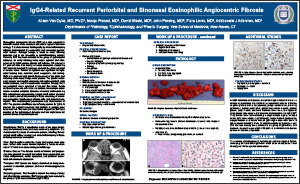IgG4-Related Recurrent Periorbital and Sinonasal Eosinophilic Angiocentric Fibrosis
Alison Van Dyke, MD, Ph.D1, Manju Prasad, MD1, David Shield, MD2, John Persing, MD3, Flora Levin, MD2, Adebowale J. Adeniran1
Departments of 1Pathology, 2Ophthalmology, and 3Plastic Surgery, Yale School of Medicine, New Haven, CT, USA
ABSTRACT
Eosinophilic angiocentric fibrosis (EAF) is a rare, progressive tumor-like lesion of the sinonasal and orbital region of unknown etiology. It is characterized histologically by mixed inflammatory infiltrate predominated by eosinophils and concentric perivas-cular fibrosis. Although benign, it tends to recur following resection and is not amenable to anti-inflammatory therapy. Recently, EAF has been included in the group of IgG4-related diseases, an entity affecting many organ systems and char-acterized by IgG4-positive plasma cell infiltrate. We present a 53 year-old man with history of nasal obstruction caused by EAF that was resected 8 years ago, and with the chief complaint of double vision. Review of systems was significant for right-sided hearing loss, recurrent nasal congestion, and tearing. Right eye proptosis with lateral displacement of the globe and widening of the nasal bridge were present. The patient under-went anterior and medial orbitotomy with right periorbital, right middle turbinate, and left nasal tumor resection. Grossly, the 3 cm periorbital mass consisted of tan-red firm tissue focally surfaced by mucosa with a tan cut surface. Microscopic exam-ination revealed complete distortion of normal architecture by fibro-collagenous onion-skinning around small-caliber arterioles with a dense, mixed inflammatory infiltrate consisting of numer-ous eosinophils, lymphocytes, plasma cells, and scattered neu-trophils. This morphological presentation was characteristic of EAF. The plasma cell infiltrate was diffusely positive for IgG4. At present, the patient’s proptosis and diplopia in primary gaze have resolved. This case provides further support for EAF as a member of the IgG4-related diseases and has implications for potential directed medical treatment.
©2012 Yale Department of Pathology. All rights reserved.
Any redistribution or reproduction of part or all of the contents in any form is prohibited. You may not, except with express written permission of the author or the Department of Pathology, distribute or commercially exploit the content, nor may you transmit it or store it in any other website or other form of electronic retrieval system, including use for educational purposes.
